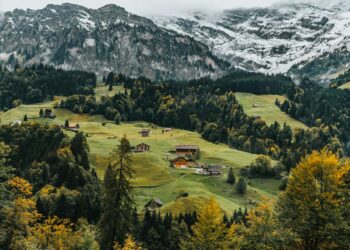Simply north of Venice lies Murano, an island the place slim canals and winding calli supply a mild distinction to the power of the mainland. Most guests, ferried in the direction of the bustling glass furnaces of Rio dei Vetrai, cross unknowingly by hidden workshops—quiet sanctuaries the place the traditional artwork of glassmaking nonetheless glints behind stone partitions and wrought-iron gates. In these secret ateliers, centuries-old secrets and techniques proceed to take form, solid by hearth and held by arms.In a single such courtyard, fortunate passersby can glimpse the artisans of Ellegi Glass Murano, shaping molten glass into delicate artworks. Those that get lost the crushed path don’t depart with mere souvenirs—they carry away tales.
In 1291, the Venetian Republic ordered all glass furnaces to be moved to Murano, out of worry that open flames might engulf the picket metropolis of Venice and to guard the island’s valuable commerce secrets and techniques. Thus started a centuries-long custom of expertise, tucked away behind weathered stone façades and ornate iron gates.Lots of Murano’s studios haven’t any indicators; their doorways open via household ties relatively than storefront shows. Wandering alongside the central canal, crossing bridges formed like lily pads, travellers typically discover themselves in secluded courtyards the place slivers of golden gentle escape via picket shutters. Inside, artisans work in silence, utilizing the identical lengthy metal pipes their ancestors did. In contrast to the bustling vacationer factories, these hidden areas supply stillness—damaged solely by the whisper of embers and the occasional low murmur of dialog. It’s right here, not in memento retailers, that true tales are solid.
Watching glass twist and stretch simply an arm’s size away feels completely different—extra intimate, extra actual. Small group excursions, restricted to simply eight company and sometimes bought out, have earned near-perfect opinions from travellers fortunate sufficient to hitch them. In these shut areas, a grasp glassmaker would possibly form a fragile horse in minutes, passing the nice and cozy creation throughout the bench so guests can really feel the fading warmth for themselves.The dialog flows simply, wealthy with dialect and satisfaction. Some studios even welcome youngsters to create their very own glass beads, turning a easy go to right into a cherished household ritual relatively than a spectator occasion.
The magic of Murano glass is rooted in historic chemistry, older than the printing press. The creation of Cristallo, perfected within the fifteenth century, stays the benchmark for purity and brilliance. Masters skillfully take away impurities utilizing manganese, then management the cooling course of to stop cracks and stress strains.The enduring murrine, often known as millefiori, begins as vibrant glass canes, sliced into floral patterns. These tiny slices are organized in moulds, gently heated, and remodeled into kaleidoscopic sheets—later formed into bowls, pendants, or nice ornaments. Typically, guests are invited to carry a still-warm disc of murrina, feeling its tough edge soften beneath their fingertips—a small, fleeting miracle that lingers.
Murano is a spot of fixed reinvention. Many furnaces are being remodeled with hybrid electrical programs to scale back prices and emissions. Designers collaborate with style homes, blowing neon-lit chandeliers one week and smooth wine glasses the following.Some manufacturers have gone even additional, restoring lagoon salt marshes to steadiness the carbon footprint of each flame. Experimental studios take a look at new pigments and shapes, revealing their creations in pop-ups all over the world. Guests who discover themselves in these inventive areas witness innovation being born earlier than their eyes, leaving with traces of glass mud on their sleeves and new reverence of their hearts.
Murano’s hidden studios are usually not museums or theme parks—they’re dwelling workshops the place hearth nonetheless writes historical past daily. Step past the principle quay and the island sheds its vacationer pores and skin, revealing artisans who nonetheless greet one another from passing boats, who steadiness custom with invention in shared areas.Right here, outdated and new sit facet by facet, sharing instruments, gossip, and glass. Those that take the time to look past the memento stalls quickly perceive why these hidden furnaces prime each traveller’s wishlist—checked off not with a trinket, however with a narrative formed by hearth and colored by molten glass.
Simply north of Venice lies Murano, an island the place slim canals and winding calli supply a mild distinction to the power of the mainland. Most guests, ferried in the direction of the bustling glass furnaces of Rio dei Vetrai, cross unknowingly by hidden workshops—quiet sanctuaries the place the traditional artwork of glassmaking nonetheless glints behind stone partitions and wrought-iron gates. In these secret ateliers, centuries-old secrets and techniques proceed to take form, solid by hearth and held by arms.In a single such courtyard, fortunate passersby can glimpse the artisans of Ellegi Glass Murano, shaping molten glass into delicate artworks. Those that get lost the crushed path don’t depart with mere souvenirs—they carry away tales.
In 1291, the Venetian Republic ordered all glass furnaces to be moved to Murano, out of worry that open flames might engulf the picket metropolis of Venice and to guard the island’s valuable commerce secrets and techniques. Thus started a centuries-long custom of expertise, tucked away behind weathered stone façades and ornate iron gates.Lots of Murano’s studios haven’t any indicators; their doorways open via household ties relatively than storefront shows. Wandering alongside the central canal, crossing bridges formed like lily pads, travellers typically discover themselves in secluded courtyards the place slivers of golden gentle escape via picket shutters. Inside, artisans work in silence, utilizing the identical lengthy metal pipes their ancestors did. In contrast to the bustling vacationer factories, these hidden areas supply stillness—damaged solely by the whisper of embers and the occasional low murmur of dialog. It’s right here, not in memento retailers, that true tales are solid.
Watching glass twist and stretch simply an arm’s size away feels completely different—extra intimate, extra actual. Small group excursions, restricted to simply eight company and sometimes bought out, have earned near-perfect opinions from travellers fortunate sufficient to hitch them. In these shut areas, a grasp glassmaker would possibly form a fragile horse in minutes, passing the nice and cozy creation throughout the bench so guests can really feel the fading warmth for themselves.The dialog flows simply, wealthy with dialect and satisfaction. Some studios even welcome youngsters to create their very own glass beads, turning a easy go to right into a cherished household ritual relatively than a spectator occasion.
The magic of Murano glass is rooted in historic chemistry, older than the printing press. The creation of Cristallo, perfected within the fifteenth century, stays the benchmark for purity and brilliance. Masters skillfully take away impurities utilizing manganese, then management the cooling course of to stop cracks and stress strains.The enduring murrine, often known as millefiori, begins as vibrant glass canes, sliced into floral patterns. These tiny slices are organized in moulds, gently heated, and remodeled into kaleidoscopic sheets—later formed into bowls, pendants, or nice ornaments. Typically, guests are invited to carry a still-warm disc of murrina, feeling its tough edge soften beneath their fingertips—a small, fleeting miracle that lingers.
Murano is a spot of fixed reinvention. Many furnaces are being remodeled with hybrid electrical programs to scale back prices and emissions. Designers collaborate with style homes, blowing neon-lit chandeliers one week and smooth wine glasses the following.Some manufacturers have gone even additional, restoring lagoon salt marshes to steadiness the carbon footprint of each flame. Experimental studios take a look at new pigments and shapes, revealing their creations in pop-ups all over the world. Guests who discover themselves in these inventive areas witness innovation being born earlier than their eyes, leaving with traces of glass mud on their sleeves and new reverence of their hearts.
Murano’s hidden studios are usually not museums or theme parks—they’re dwelling workshops the place hearth nonetheless writes historical past daily. Step past the principle quay and the island sheds its vacationer pores and skin, revealing artisans who nonetheless greet one another from passing boats, who steadiness custom with invention in shared areas.Right here, outdated and new sit facet by facet, sharing instruments, gossip, and glass. Those that take the time to look past the memento stalls quickly perceive why these hidden furnaces prime each traveller’s wishlist—checked off not with a trinket, however with a narrative formed by hearth and colored by molten glass.
Simply north of Venice lies Murano, an island the place slim canals and winding calli supply a mild distinction to the power of the mainland. Most guests, ferried in the direction of the bustling glass furnaces of Rio dei Vetrai, cross unknowingly by hidden workshops—quiet sanctuaries the place the traditional artwork of glassmaking nonetheless glints behind stone partitions and wrought-iron gates. In these secret ateliers, centuries-old secrets and techniques proceed to take form, solid by hearth and held by arms.In a single such courtyard, fortunate passersby can glimpse the artisans of Ellegi Glass Murano, shaping molten glass into delicate artworks. Those that get lost the crushed path don’t depart with mere souvenirs—they carry away tales.
In 1291, the Venetian Republic ordered all glass furnaces to be moved to Murano, out of worry that open flames might engulf the picket metropolis of Venice and to guard the island’s valuable commerce secrets and techniques. Thus started a centuries-long custom of expertise, tucked away behind weathered stone façades and ornate iron gates.Lots of Murano’s studios haven’t any indicators; their doorways open via household ties relatively than storefront shows. Wandering alongside the central canal, crossing bridges formed like lily pads, travellers typically discover themselves in secluded courtyards the place slivers of golden gentle escape via picket shutters. Inside, artisans work in silence, utilizing the identical lengthy metal pipes their ancestors did. In contrast to the bustling vacationer factories, these hidden areas supply stillness—damaged solely by the whisper of embers and the occasional low murmur of dialog. It’s right here, not in memento retailers, that true tales are solid.
Watching glass twist and stretch simply an arm’s size away feels completely different—extra intimate, extra actual. Small group excursions, restricted to simply eight company and sometimes bought out, have earned near-perfect opinions from travellers fortunate sufficient to hitch them. In these shut areas, a grasp glassmaker would possibly form a fragile horse in minutes, passing the nice and cozy creation throughout the bench so guests can really feel the fading warmth for themselves.The dialog flows simply, wealthy with dialect and satisfaction. Some studios even welcome youngsters to create their very own glass beads, turning a easy go to right into a cherished household ritual relatively than a spectator occasion.
The magic of Murano glass is rooted in historic chemistry, older than the printing press. The creation of Cristallo, perfected within the fifteenth century, stays the benchmark for purity and brilliance. Masters skillfully take away impurities utilizing manganese, then management the cooling course of to stop cracks and stress strains.The enduring murrine, often known as millefiori, begins as vibrant glass canes, sliced into floral patterns. These tiny slices are organized in moulds, gently heated, and remodeled into kaleidoscopic sheets—later formed into bowls, pendants, or nice ornaments. Typically, guests are invited to carry a still-warm disc of murrina, feeling its tough edge soften beneath their fingertips—a small, fleeting miracle that lingers.
Murano is a spot of fixed reinvention. Many furnaces are being remodeled with hybrid electrical programs to scale back prices and emissions. Designers collaborate with style homes, blowing neon-lit chandeliers one week and smooth wine glasses the following.Some manufacturers have gone even additional, restoring lagoon salt marshes to steadiness the carbon footprint of each flame. Experimental studios take a look at new pigments and shapes, revealing their creations in pop-ups all over the world. Guests who discover themselves in these inventive areas witness innovation being born earlier than their eyes, leaving with traces of glass mud on their sleeves and new reverence of their hearts.
Murano’s hidden studios are usually not museums or theme parks—they’re dwelling workshops the place hearth nonetheless writes historical past daily. Step past the principle quay and the island sheds its vacationer pores and skin, revealing artisans who nonetheless greet one another from passing boats, who steadiness custom with invention in shared areas.Right here, outdated and new sit facet by facet, sharing instruments, gossip, and glass. Those that take the time to look past the memento stalls quickly perceive why these hidden furnaces prime each traveller’s wishlist—checked off not with a trinket, however with a narrative formed by hearth and colored by molten glass.
Simply north of Venice lies Murano, an island the place slim canals and winding calli supply a mild distinction to the power of the mainland. Most guests, ferried in the direction of the bustling glass furnaces of Rio dei Vetrai, cross unknowingly by hidden workshops—quiet sanctuaries the place the traditional artwork of glassmaking nonetheless glints behind stone partitions and wrought-iron gates. In these secret ateliers, centuries-old secrets and techniques proceed to take form, solid by hearth and held by arms.In a single such courtyard, fortunate passersby can glimpse the artisans of Ellegi Glass Murano, shaping molten glass into delicate artworks. Those that get lost the crushed path don’t depart with mere souvenirs—they carry away tales.
In 1291, the Venetian Republic ordered all glass furnaces to be moved to Murano, out of worry that open flames might engulf the picket metropolis of Venice and to guard the island’s valuable commerce secrets and techniques. Thus started a centuries-long custom of expertise, tucked away behind weathered stone façades and ornate iron gates.Lots of Murano’s studios haven’t any indicators; their doorways open via household ties relatively than storefront shows. Wandering alongside the central canal, crossing bridges formed like lily pads, travellers typically discover themselves in secluded courtyards the place slivers of golden gentle escape via picket shutters. Inside, artisans work in silence, utilizing the identical lengthy metal pipes their ancestors did. In contrast to the bustling vacationer factories, these hidden areas supply stillness—damaged solely by the whisper of embers and the occasional low murmur of dialog. It’s right here, not in memento retailers, that true tales are solid.
Watching glass twist and stretch simply an arm’s size away feels completely different—extra intimate, extra actual. Small group excursions, restricted to simply eight company and sometimes bought out, have earned near-perfect opinions from travellers fortunate sufficient to hitch them. In these shut areas, a grasp glassmaker would possibly form a fragile horse in minutes, passing the nice and cozy creation throughout the bench so guests can really feel the fading warmth for themselves.The dialog flows simply, wealthy with dialect and satisfaction. Some studios even welcome youngsters to create their very own glass beads, turning a easy go to right into a cherished household ritual relatively than a spectator occasion.
The magic of Murano glass is rooted in historic chemistry, older than the printing press. The creation of Cristallo, perfected within the fifteenth century, stays the benchmark for purity and brilliance. Masters skillfully take away impurities utilizing manganese, then management the cooling course of to stop cracks and stress strains.The enduring murrine, often known as millefiori, begins as vibrant glass canes, sliced into floral patterns. These tiny slices are organized in moulds, gently heated, and remodeled into kaleidoscopic sheets—later formed into bowls, pendants, or nice ornaments. Typically, guests are invited to carry a still-warm disc of murrina, feeling its tough edge soften beneath their fingertips—a small, fleeting miracle that lingers.
Murano is a spot of fixed reinvention. Many furnaces are being remodeled with hybrid electrical programs to scale back prices and emissions. Designers collaborate with style homes, blowing neon-lit chandeliers one week and smooth wine glasses the following.Some manufacturers have gone even additional, restoring lagoon salt marshes to steadiness the carbon footprint of each flame. Experimental studios take a look at new pigments and shapes, revealing their creations in pop-ups all over the world. Guests who discover themselves in these inventive areas witness innovation being born earlier than their eyes, leaving with traces of glass mud on their sleeves and new reverence of their hearts.
Murano’s hidden studios are usually not museums or theme parks—they’re dwelling workshops the place hearth nonetheless writes historical past daily. Step past the principle quay and the island sheds its vacationer pores and skin, revealing artisans who nonetheless greet one another from passing boats, who steadiness custom with invention in shared areas.Right here, outdated and new sit facet by facet, sharing instruments, gossip, and glass. Those that take the time to look past the memento stalls quickly perceive why these hidden furnaces prime each traveller’s wishlist—checked off not with a trinket, however with a narrative formed by hearth and colored by molten glass.













